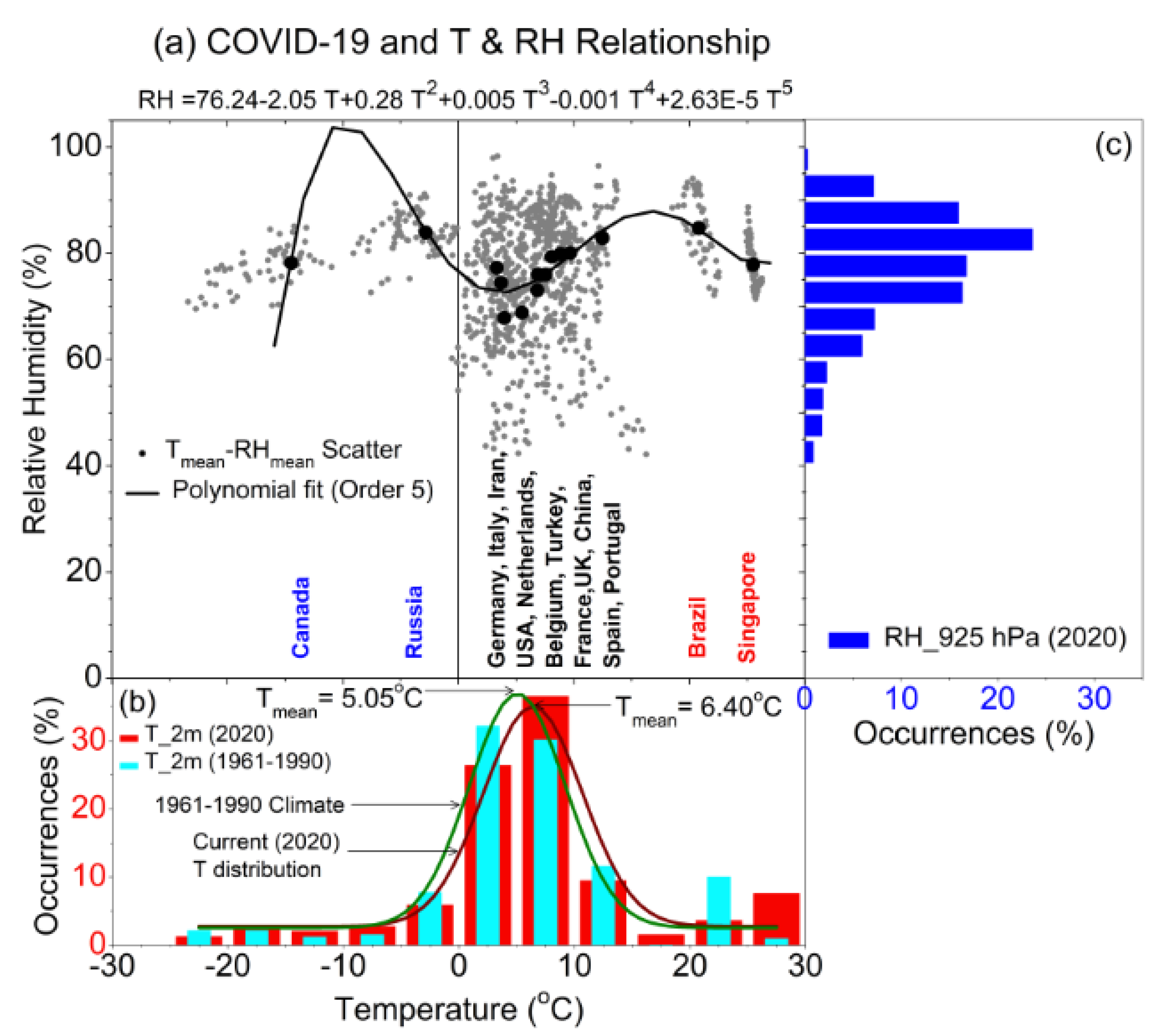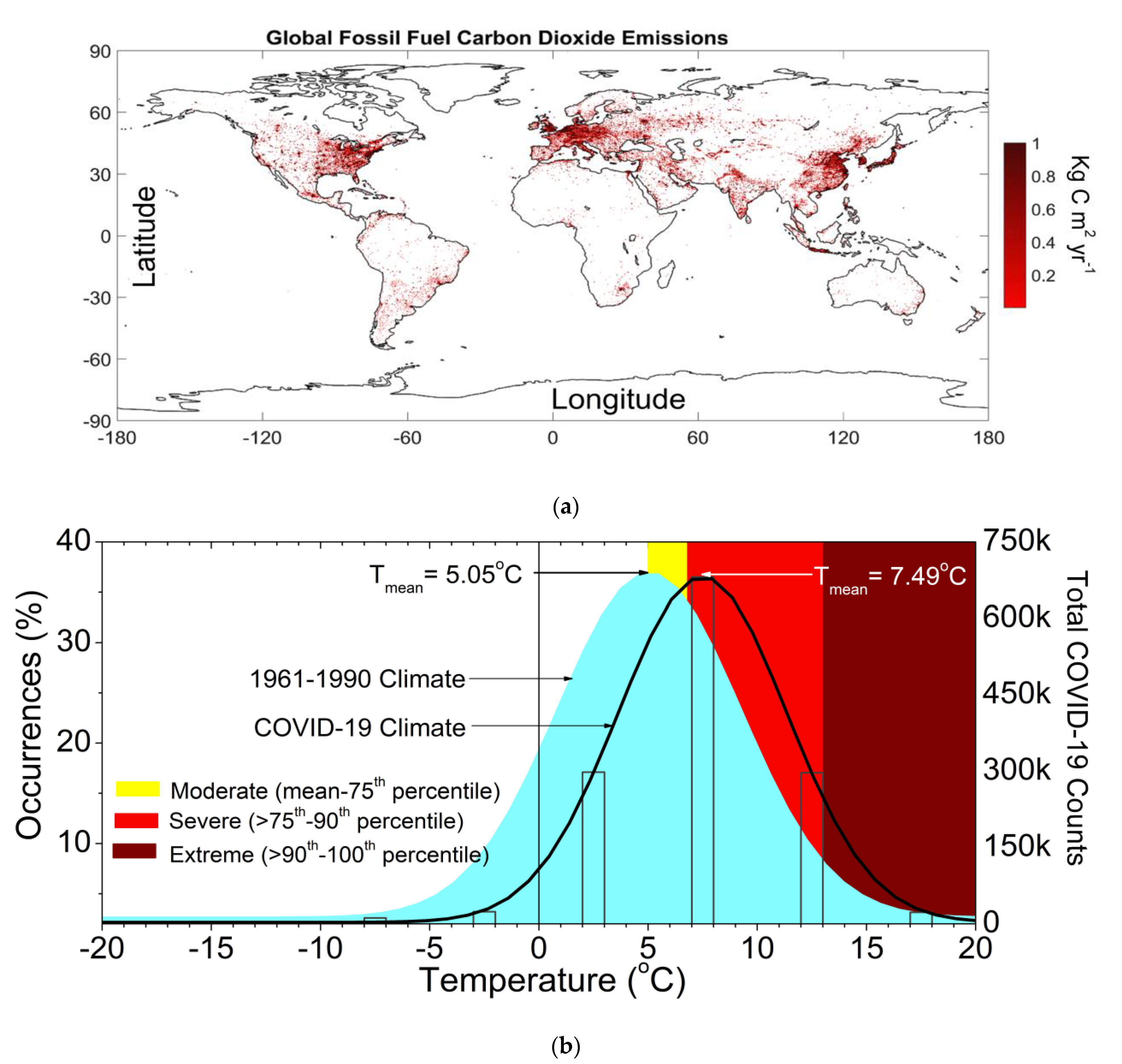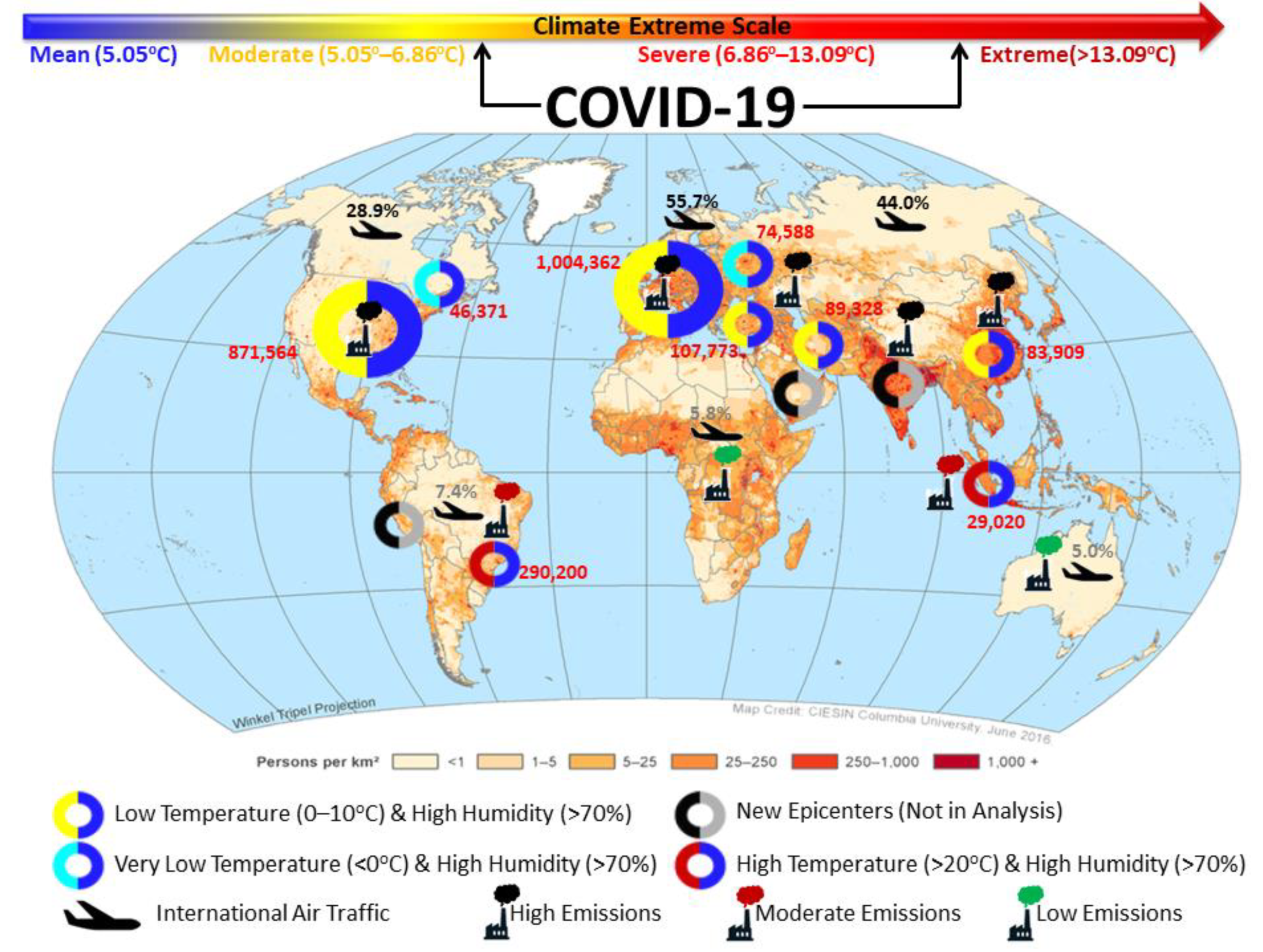Factors Affecting COVID-19 Outbreaks across the Globe: Role of Extreme Climate Change
Abstract
1. Introduction
2. Population Density
3. International Air Transport Traffic
4. Pollution
5. Ambient Temperature and Relative Humidity
6. CO2 Emission, Global Warming and Climate Change
7. Summary and Conclusions
8. Data
9. Materials and Methods
Supplementary Materials
Author Contributions
Funding
Institutional Review Board Statement
Informed Consent Statement
Competing Interest Statement
Data Availability Statement
Code Availability Statement
Acknowledgments
Conflicts of Interest
References
- Center for Strategic and International Studies (CSIS) Report. 2020. Available online: https://www.csis.org/analysis/global-economic-impacts-covid-19 (accessed on 1 May 2020).
- She, J.; Jiang, J.; Ye, L.; Hu, L.; Bai, C.; Song, Y. 2019 novel coronavirus of pneumonia in Wuhan, China: Emerging attack and management strategies. Clin. Transl. Med. 2020, 9, 19. [Google Scholar] [CrossRef] [PubMed]
- Zhu, N.; Zhang, D.; Wang, W.; Li, X.; Yang, B.; Song, J.; Zhao, X.; Huang, B.; Shi, W.; Lu, R.; et al. A Novel Coronavirus from Patients with Pneumonia in China, 2019. N. Engl. J. Med. 2020, 382, 727–733. [Google Scholar] [CrossRef] [PubMed]
- Huang, C.; Wang, Y.; Li, X.; Ren, L.; Zhao, J.; Hu, Y.; Zhang, L.; Fan, G.; Xu, J.; Gu, X.; et al. Clinical features of patients infected with 2019 novel coronavirus in Wuhan, China. Lancet 2020, 395, 497–506. [Google Scholar] [CrossRef]
- Pneumonia of Unknown Cause—China. WHO Disease Outbreak News, 5 January 2020.
- WHO Situation Reports; WHO: Geneva, Switzerland, 2020; pp. 1–100.
- Liu, J.; Liao, X.; Qian, S.; Yuan, J.; Wang, F.; Liu, Y.; Wang, Z.; Wang, F.-S.; Liu, L.; Zhang, Z. Community Transmission of Severe Acute Respiratory Syndrome Coronavirus 2, Shenzhen, China, 2020. Emerg. Infect. Dis. 2020, 26. [Google Scholar] [CrossRef] [PubMed]
- Chan, J.F.-W.; Yuan, S.; Kok, K.-H.; To, K.K.-W.; Chu, H.; Yang, J.; Xing, F.; Liu, J.; Yip, C.C.-Y.; Poon, R.W.-S.; et al. A familial cluster of pneumonia associated with the 2019 novel coronavirus indicating person-to-person transmission: A study of a family cluster. Lancet 2020, 395, 514–523. [Google Scholar] [CrossRef]
- Li, Q.; Guan, X.; Wu, P.; Qun, L.; Xuhua, G.; Peng, W.; Xiaoye, W.; Lei, Z.; Yeqing, T.; Ruiqi, R.; et al. Early transmission dynamics in Wuhan, China, of Novel Coronavirus—Infected pneumonia. N. Engl. J. Med. 2020, 382, 1199–1207. [Google Scholar] [CrossRef] [PubMed]
- Burke, R.M.; Midgley, C.M.; Dratch, A.; Fenstersheib, M.; Haupt, T.; Holshue, M.; Ghinai, I.; Jarashow, M.C.; Lo, J.; McPherson, T.D.; et al. Active monitoring of persons exposed to patients with confirmed COVID-19—United States, January–February 2020. Morb. Mortal. Wkly. Rep. 2020, 69, 245. [Google Scholar] [CrossRef] [PubMed]
- World Health Organization. Report of the WHO-China Joint Mission on Coronavirus Disease 2019 (COVID-19) 16–24 February 2020; World Health Organization: Geneva, Switzerland, 2020; Available online: https://www.who.int/docs/default-source/coronaviruse/whochina-joint-mission-on-covid-19-final-report.pdf (accessed on 25 April 2020).
- WHO. Modes of Transmission of Virus Causing COVID-19: Implications for IPC Precaution Recommendations; WHO: Geneva, Switzerland, 2020. [Google Scholar]
- Wong, C.-M.; Thach, T.Q.; Chau, P.Y.K.; Chan, E.K.P.; Chung, R.Y.-N.; Ou, C.-Q.; Yang, L.; Peiris, J.S.M.; Thomas, G.N.; Lam, T.-H.; et al. Part 4. Interaction between air pollution and respiratory viruses: Time-series study of daily mortality and hospital admissions in Hong Kong. Res. Rep. (Health Eff. Institute) 2010, 154, 283–362. [Google Scholar]
- Silva, D.R.; Viana, V.P.; Müller, A.M.; Livi, F.P.; Dalcin, P.D.T.R. Respiratory viral infections and effects of meteorological parameters and air pollution in adults with respiratory symptoms admitted to the emergency room. Influ. Other Respir. Viruses 2014, 8, 42–52. [Google Scholar] [CrossRef] [PubMed]
- Weber, T.P.; Stilianakis, N.I. Inactivation of influenza A viruses in the environment and modes of transmission: A critical review. J. Infect. 2008, 57, 361–373. [Google Scholar] [CrossRef]
- Pyankov, O.V.; Bodnev, S.A.; Pyankova, O.G.; Agranovski, I.E. Survival of aerosolized coronavirus in the ambient air. J. Aerosol. Sci. 2018, 115, 158–163. [Google Scholar] [CrossRef] [PubMed]
- Chan, K.H.; Peiris, J.S.M.; Lam, S.Y.; Poon, L.L.M.; Yuen, K.Y.; Seto, W.H. The Effects of Temperature and Relative Humidity on the Viability of the SARS Coronavirus. Adv. Virol. 2011, 2011, 734690. [Google Scholar] [CrossRef] [PubMed]
- Mecenas, P.; da Rosa Moreira Bastos, R.T.; Rosario Vallinoto, A.C.; Normando, D. Effects of temperature and humidity on the spread of COVID-19: A systematic review. PLoS ONE 2020, 15, e0238339. [Google Scholar] [CrossRef]
- Oliveiros, B.; Caramelo, L.; Ferreira, N.C.; Caramelo, F. Role of Temperature and Humidity in the Modulation of the Doubling Time of COVID-19 Cases. 2020. Available online: https://www.medrxiv.org/content/10.1101/2020.03.05.20031872v1 (accessed on 28 April 2020).
- Sasikumar, K.; Nath, D.; Nath, R.; Chen, W. Impact of Extreme Hot Climate on COVID-19 Outbreak in India. GeoHealth 2020, 4, 000305. [Google Scholar] [CrossRef] [PubMed]
- Naicker, P.R. The impact of climate change and other factors on zoonotic diseases. Arch. Clin. Microbiol. 2011, 2. [Google Scholar]
- Pappas, G. Of mice and men: Defining, categorizing and understanding the significance of zoonotic infections. Clin. Microbiol. Infect. 2011, 17, 321–325. [Google Scholar] [CrossRef] [PubMed]
- Cutler, S.J.; Fooks, A.R.; Van Der Poel, W.H.M. Public Health Threat of New, Reemerging, and Neglected Zoonoses in the Industrialized World. Emerg. Infect. Dis. 2010, 16, 1–7. [Google Scholar] [CrossRef] [PubMed]
- Sachan, N.; Singh, V.P. Effect of climatic changes on the prevalence of zoonotic diseases. Vet. World 2010, 3, 519–522. [Google Scholar]
- Wang, L.-F.; Shi, Z.; Zhang, S.; Field, H.; Daszak, P.; Eaton, B.T. Review of Bats and SARS. Emerg. Infect. Dis. 2006, 12, 1834–1840. [Google Scholar] [CrossRef] [PubMed]
- Intergovernmental Panel on Climate Change (IPCC). Climate Change 2007: Synthesis Report—Summary for Policymakers. Available online: http://www.ipcc.ch/pdf/assessment-report/ar4/syr/ar4_syr_spm.pdf (accessed on 6 May 2010).
- Lacetera, N. Impact of climate change on animal health and welfare. Anim. Front. 2019, 9, 26–31. [Google Scholar] [CrossRef] [PubMed]
- Lancet, T. COVID-19: Too little, too late? Lancet 2020, 395, 755–838. [Google Scholar] [CrossRef]
- Socioeconomic Data and Applications Center (SEDAC). Gridded Population of the World (GPW), v3 2020. Available online: http://dx.doi.org/10.7927/H4639MPP (accessed on 1 May 2020).
- Colizza, V.; Barrat, A.; Barthélemy, M.; Vespignani, A. The role of the airline transportation network in the prediction and predictability of global epidemics. Proc. Natl. Acad. Sci. USA 2006, 103, 2015–2020. [Google Scholar] [CrossRef]
- The International Civil Aviation Organization (ICAO). Available online: https://www.icao.int/Security/COVID-19/Pages/default.aspx (accessed on 1 May 2020).
- The Global Airport Database. Available online: https://www.partow.net/miscellaneous/airportdatabase/ (accessed on 1 May 2020).
- IATA. International Air Transport Association Report; IATA: Montreal, QC, Canada, 2019. [Google Scholar]
- Bukhari, Q.; Jameel, Y. Will Coronavirus Pandemic Diminish by Summer? SSRN Electron. J. 2020. [Google Scholar] [CrossRef]
- Wong, T.W.; Lau, T.S.; Yu, T.S.; Neller, A.; Wong, S.L.; Tam, W.; Pang, S.W. Air pollution and hospital admissions for respiratory and cardiovascular diseases in Hong Kong. Occup. Environ. Med. 1999, 56, 679–683. [Google Scholar] [CrossRef] [PubMed]
- Ciencewicki, J.; Jaspers, I. Air Pollution and Respiratory Viral Infection. Inhal. Toxicol. 2007, 19, 1135–1146. [Google Scholar] [CrossRef] [PubMed]
- Zhu, Y.; Xie, J.; Huang, F.; Cao, L. Association between short-term exposure to air pollution and COVID-19 infection: Evidence from China. Sci. Total Environ. 2020, 727, 138704. [Google Scholar] [CrossRef] [PubMed]
- Fattorini, D.; Regoli, F. Role of the chronic air pollution levels in the Covid-19 outbreak risk in Italy. Environ. Pollut. 2020, 264, 114732. [Google Scholar] [CrossRef] [PubMed]
- Pansini, R.; Fornacca, D. Higher Virulence of COVID-19 in the Air-Polluted Regions of Eight Severely Affected Countries. Available online: https://www.medrxiv.org/content/101101/2020043020086496v2 (accessed on 1 May 2020).
- Pozzer, A.; Dominici, F.; Haines, A.; Witt, C.; Münzel, T.; Lelieveld, J. Regional and global contributions of air pollution to risk of death from COVID-19. Cardiovasc. Res. 2020, 116, 2247–2253. [Google Scholar] [CrossRef] [PubMed]
- van Donkelaar, A.; Martin, R.V.; Brauer, M.; Boys, B.L. Global Annual PM2.5 Grids from MODIS, MISR and SeaWiFS Aerosol Optical Depth (AOD), 1998–2012; NASA Socioeconomic Data and Applications Center (SEDAC): Palisades, NY, USA, 2015. [Google Scholar] [CrossRef]
- Peng, R.D.; Dominici, F.; Pastor-Barriuso, R.; Zeger, S.L.; Samet, J.M. Seasonal Analyses of Air Pollution and Mortality in 100 US Cities. Am. J. Epidemiol. 2005, 161, 585–594. [Google Scholar] [CrossRef] [PubMed]
- Bedford, T.; Riley, S.; Barr, I.G.; Broor, S.; Chadha, M.; Cox, N.J.; Daniels, R.S.; Gunasekaran, C.P.; Hurt, A.C.; Kelso, A.; et al. Global circulation patterns of seasonal influenza viruses vary with antigenic drift. Nat. Cell Biol. 2015, 523, 217–220. [Google Scholar] [CrossRef] [PubMed]
- Lemaitre, J.; Pasetto, D.; Perez-Saez, J.; Sciarra, C.; Wamala, J.F.; Rinaldo, A. Rainfall as a driver of epidemic cholera: Comparative model assessments of the effect of intra-seasonal precipitation events. Acta Trop. 2019, 190, 235–243. [Google Scholar] [CrossRef] [PubMed]
- Tamerius, J.D.; Shaman, J.; Alonso, W.J.; Bloom-Feshbach, K.; Uejio, C.K.; Comrie, A.; Viboud, C. Environmental Predictors of Seasonal Influenza Epidemics across Temperate and Tropical Climates. PLOS Pathog. 2013, 9, e1003194. [Google Scholar] [CrossRef]
- World Health Organization. WHO Coronavirus Disease (COVID-19) Dashboard. 2020. Available online: https://covid19.who.int/ (accessed on 3 March 2021).
- Johns Hopkins University (JHU). COVID-19 Dashboard. 2020. Available online: https://coronavirus.jhu.edu/ (accessed on 25 April 2020).
- King, A.D.; Karoly, D.J.; Henley, B.J. Australian climate extremes at 1.5 °C and 2 °C of global warming. Nat. Clim. Chang. 2017, 7, 412–416. [Google Scholar] [CrossRef]
- Vinke, K.; Schellnhuber, H.J.; Coumou, D.; Geiger, T.; Glanemann, N.; Huber, V.; Kropp, J.P.; Kriewald, S.; Lehmann, J.; Levermann, A.; et al. A Region at Risk: The Human Dimensions of Climate Change in Asia and the Pacific; Asian Development Bank (ADB): Mandaluyong, Philippines, 2017. [Google Scholar] [CrossRef]
- Rogelj, J.; Den Elzen, M.; Höhne, N.; Fransen, T.; Fekete, H.; Winkler, H.; Schaeffer, R.; Sha, F.; Riahi, K.; Meinshausen, M. Paris Agreement climate proposals need a boost to keep warming well below 2 °C. Nature 2011, 534, 631–639. [Google Scholar] [CrossRef]
- Wittmann, E.; Mellor, P.; Baylis, M. Using climate data to map the potential distribution of Culicoides imicola (Diptera: Ceratopogonidae) in Europe. Rev. Sci. Tech. Off. Int. Epizoot. 2001, 20, 731–740. [Google Scholar] [CrossRef]
- Allen, T.; Murray, K.A.; Zambrana-Torrelio, C.; Morse, S.S.; Rondinini, C.; Di Marco, M.; Breit, N.; Olival, K.J.; Daszak, P. Global hotspots and correlates of emerging zoonotic diseases. Nat. Commun. 2017, 8, 1124. [Google Scholar] [CrossRef] [PubMed]




| Sr. No. | Continent | Country | City/States | Latitude & Longitude | Distance from Waterbody (km) | Cumulative Counts |
|---|---|---|---|---|---|---|
| 1 | North America | United States of America | New York | 40.71 N, 74 W | 2.4 | 287,898 |
| 2 | New Jersey | 39.83 N, 74.87 W | 68.5 | 105,198 | ||
| 3 | Michigan | 44.18 N, 84.5 W | 25 | 38,789 | ||
| 4 | Massachusetts | 42.40 N, 71.38 W | 5 | 57,537 | ||
| 5 | Pennsylvania | 41.2 N, 77.19 W | 344 | 41,153 | ||
| 6 | California | 36.77 N, 119.4 W | 200 | 42,771 | ||
| 7 | Louisiana | 30.39 N, 92.32 W | 120 | 95,058 | ||
| 8 | Illinois | 39.83 N, 89.64 W | 10 | 41,777 | ||
| 9 | Florida | 27.66 N, 81.51 W | 75 | 30,839 | ||
| 10 | Texas | 31.16N, 99.68 W | 500 | 24,287 | ||
| 11 | Georgia | 33.24 N, 83.44 W | 200 | 23,222 | ||
| 12 | Connecticut | 41.51 N, 72.66 W | 50 | 24,583 | ||
| 13 | Washington | 47.75 N, 120.74 W | 250 | 13,319 | ||
| 14 | Maryland | 38.95 N, 76.70 W | 100 | 17,766 | ||
| 15 | Indiana | 39.91 N, 86.28 W | 200 | 14,399 | ||
| 16 | Colorado | 38.99 N, 105.54 W | 1000 | 12,968 | ||
| 17 | Canada | Quebec | 53.21 N, 72.45 W | 300 | 46,371 | |
| 18 | Europe | Italy | Lombardy | 45.46 N, 9.18 E | 200 | 195,351 |
| 19 | Emilia-Romagna | 44.49 N, 11.32 E | 100 | |||
| 20 | Piedmont | 45 N, 7.68 E | 100 | |||
| 21 | Veneto | 45.54 N, 11.55 E | 25 | |||
| 22 | Germany | Bavaria | 48.13 N, 11.57 E | 250 | 156,513 | |
| 23 | North Rhine-Westphalia | 50.73 N, 7.09 E | 150 | |||
| 24 | Baden-Wurttemberg | 48.75 N, 8.24 E | 300 | |||
| 25 | Spain | Catalonia | 41.35 N, 1.49 E | 75 | 205,905 | |
| 26 | Madrid | 40.25 N, 3.42 W | 250 | |||
| 27 | Castile-La Mancha | 39.85 N, 4.02 W | 200 | |||
| 28 | Castila Leon | 41.65 N, 4.72 W | 150 | |||
| 29 | Andalusia | 37.78 N, 3.78 W | 100 | |||
| 30 | Valencia | 39.46 N, 0.36 E | 5 | |||
| 31 | Galicia | 42.46 N, 7.24 E | 75 | |||
| 32 | Basque Country | 43.26 N, 2.92 W | 25 | |||
| 34 | France | Ile-de-France | 48.84 N, 2.63 E | 125 | 161,647 | |
| 35 | Alsace-Champagne-Ardenne-Lorraine | 48.79 N, 4.47 E | 300 | |||
| 36 | UK | England | 51.30 N, 0.7 W | 100 | 155,453 | |
| 37 | Netherlands | North Brabant | 51.57 N, 4.76 E | 50 | 37,384 | |
| 38 | Amsterdam | 52.35 N, 5.00 W | 5 | |||
| 39 | Belgium | Hasselt | 50.92 N, 5.33 E | 20 | 45,325 | |
| 40 | Portugal | Porto | 41.14 N, 8.61 W | 3 | 23,392 | |
| 41 | Turkey | Istanbul | 41.01 N, 28.97 E | 2 | 107,773 | |
| 42 | Izmir | 38.41 N, 27.12 E | 1 | |||
| 43 | Trabzon | 41.00 N, 39.71 E | 1 | |||
| 44 | Russia | Moscow City | 46.73 N, 117 W | 915 | 74,588 | |
| 45 | South America | Brazil | Sao Paulo | 23.55 S, 46.63 W | 50 | 290,200 |
| 46 | Asia | China | Wuhan | 30.58 N, 114.26 E | 832 | 83,909 |
| 47 | Singapore | Singapore | 1.22 N, 103.48 E | 10 | 29,020 | |
| 48 | Iran | Tehran | 35.69 N, 51.42 E | 75 | 89,328 |
Publisher’s Note: MDPI stays neutral with regard to jurisdictional claims in published maps and institutional affiliations. |
© 2021 by the authors. Licensee MDPI, Basel, Switzerland. This article is an open access article distributed under the terms and conditions of the Creative Commons Attribution (CC BY) license (http://creativecommons.org/licenses/by/4.0/).
Share and Cite
Nath, D.; Sasikumar, K.; Nath, R.; Chen, W. Factors Affecting COVID-19 Outbreaks across the Globe: Role of Extreme Climate Change. Sustainability 2021, 13, 3029. https://doi.org/10.3390/su13063029
Nath D, Sasikumar K, Nath R, Chen W. Factors Affecting COVID-19 Outbreaks across the Globe: Role of Extreme Climate Change. Sustainability. 2021; 13(6):3029. https://doi.org/10.3390/su13063029
Chicago/Turabian StyleNath, Debashis, Keerthi Sasikumar, Reshmita Nath, and Wen Chen. 2021. "Factors Affecting COVID-19 Outbreaks across the Globe: Role of Extreme Climate Change" Sustainability 13, no. 6: 3029. https://doi.org/10.3390/su13063029
APA StyleNath, D., Sasikumar, K., Nath, R., & Chen, W. (2021). Factors Affecting COVID-19 Outbreaks across the Globe: Role of Extreme Climate Change. Sustainability, 13(6), 3029. https://doi.org/10.3390/su13063029






